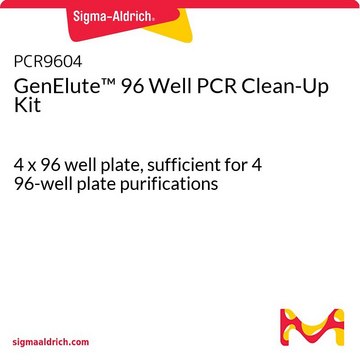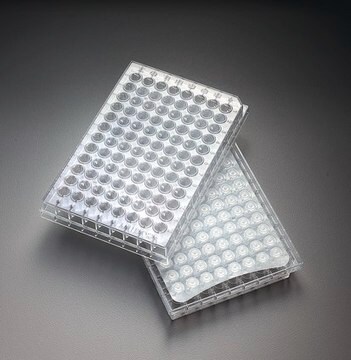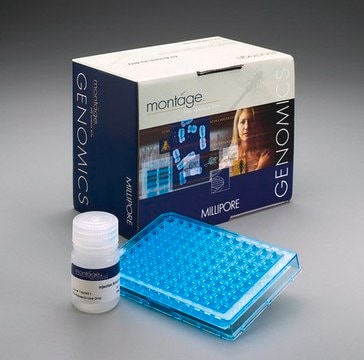NA1020
GenElute™ PCR Clean-Up Kit
sufficient for 70 purifications
Synonym(s):
Gen Elute, PCR Purification
About This Item
Recommended Products
usage
sufficient for 70 purifications
Quality Level
technique(s)
DNA purification: suitable
storage temp.
15-25°C
General description
DNA is bound on a silica membrane within the spin column. The bound DNA is washed and the clean, concentrated DNA is eluted in the buffer of choice. Each column can purify up to 100 μL or 10 μg of PCR amplified DNA and recover up to 95% of PCR products between 100 bp and 10 kb. More than 99% of the primers and most primer-dimers (<40 bp) are removed.
Purified DNA can be used in enzymatic reactions, conventional or automated sequencing, cloning and microarray analysis.
Application
Features and Benefits
- Purifies up to 100 μl or 10 μg of PCR amplified DNA in 8 minutes
- Recovers up to 95% of PCR products between 100 bp and 10 kb
- Removes over 99% of primers and other components
- Eliminates the need to remove mineral oil by organic extraction
- 40% more purification preps supplied than market leader
- Recovers up to 95% of PCR products between 100 bp and 10 kb
- Purifies up to 100 μL or 10 μg of PCR amplified DNA in 8 minutes
- Removes over 99% of primers and other components
Other Notes
Principle
Legal Information
signalword
Warning
hcodes
Hazard Classifications
Acute Tox. 4 Oral - Eye Irrit. 2 - Met. Corr. 1 - Skin Irrit. 2 - STOT SE 3
target_organs
Central nervous system
Storage Class
8A - Combustible corrosive hazardous materials
flash_point_f
Not applicable
flash_point_c
Not applicable
Choose from one of the most recent versions:
Already Own This Product?
Find documentation for the products that you have recently purchased in the Document Library.
Customers Also Viewed
Articles
After you have performed a CRISPR experiment it is important to determine which gRNAs performed successfully editing. There are many ways to validate CRISPR gene editing experiments. A quick and easy way to check for cutting is by using the Sigma-Aldrich® T7E1 mismatch detection kit.
The Extract-N-Amp™ kits are designed to rapidly extract and amplify genomic DNA. The plant tissue version of these kits has been optimized to amplify without concern over plant inhibitors. This technical document will discuss the versions of this kit that are available and help you find the best kit suited for your needs.
Understand how mRNA vaccines induce immunity. and read how synthetic mRNA is prepared for vaccine immunogens and other biopharmaceuticals. Find reagents for synthesis of mRNA.
Protocols
The SeqPlex DNA Amplification Kit for whole genome amplification (WGA) is designed to facilitate next-generation sequencing (NGS) from extremely small quantities or from degraded/highly fragmented DNA
Whole Genome Amplification can be performed on DNA extracted in many ways. We offer many products for DNA extraction, including the GenElute™ Blood Genomic DNA Kit, GenElute Mammalian Genomic DNA Miniprep Kit and the GenElute Plant Genomic DNA M iniprep.
Blood cards provide the convenience of archiving small volumes of blood. However, many times genomic DNA from these samples is limited, This protocol provides a simple and convenient method to extract genomic DNA from a blood card. Once the DNA has been extracted, it can then be amplified using the amplification protocol
Whole blood is a common source of material used to perform genetic analysis. Many times genomic DNA isolated from whole blood samples is of low yield. This protocol is a simple method to isolate DNA from fresh or aged whole blood products. Once the DNA is isolated, it can be amplified using the GenomePlex® Whole Genome Amplification protocol.
Related Content
Overview of common techniques and downstream applications for extraction and purification of genomic DNA, plasmid DNA, and total RNA from cells, tissue, blood, viruses, and other sample types.
Our team of scientists has experience in all areas of research including Life Science, Material Science, Chemical Synthesis, Chromatography, Analytical and many others.
Contact Technical Service












